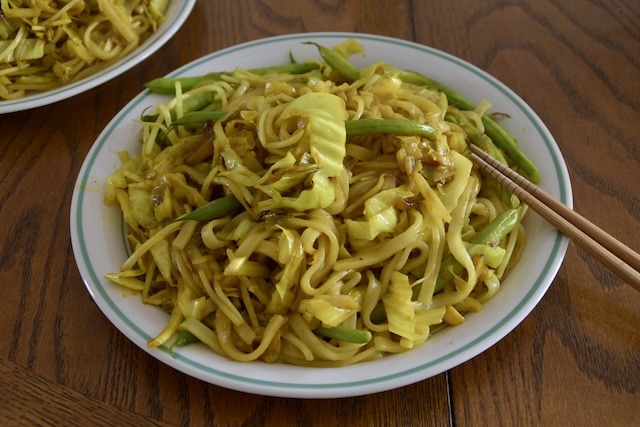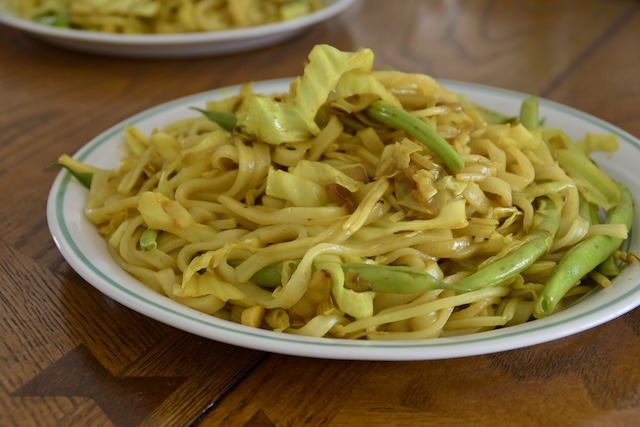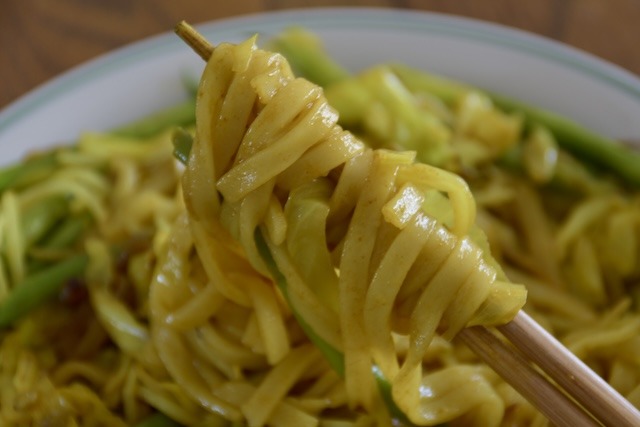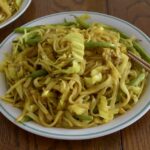Spicy, warming, and hearty, this fusion between Japanese yaki udon and Burmese stir-fry is fully vegan, healthy and delicious.

A couple of weeks ago I was browsing the cookbook section of the library and checked out a copy of Naomi Duguid’s Burma: Rivers of Flavor. Since then, I’ve made my way through several of the book’s vegetarian recipes. I especially enjoyed the Silky Shan Soup (a quick soup thickened with chickpea flour), which I’ve made many times for lunch in a pinch.
Many of the recipes I tried from the book made use of shallots – fresh, fried, or in oil form – along with turmeric. This turmeric yaki udon recipe is not an authentic dish and is Burmese-inspired in the loosest sense. In fact, instead of Burmese-inspired, it is perhaps more accurately, Burma: Rivers of Flavor-inspired.
“Central Burmese curries are generally made of meat, fish, or vegetables cooked in plenty of oil with simple flavorings: sliced shallot and turmeric, sometimes garlic, a little chile pepper (usually in powdered, dried form), and possibly ginger. Kachin and Shan curries use more fresh herbs.”
Burma: Rivers of Flavor
My turmeric yaki udon follows this format, with a base of sliced shallots and turmeric, which flavors a great deal of vegetables and oodles of noodles.
What’s in the dish? Ingredients, where to find, and substitutions
- Shallots: Shallots are the aromatic backbone of my turmeric fried udon. If you don’t have shallots, use thinly sliced onions instead.
- Turmeric powder: Well known to be anti-inflammatory, turmeric is widely available at most grocery stores in the spice section. There is no substitution for turmeric. Be warned that turmeric will stain plastic yellow.
- Thai chilli peppers: Fresh green or red Thai chilli peppers brings the heat. Fully optional, omit if you want a mild dish. I had an excess of fresh chiles so that is what I used. Substitute with dried chiles: ground, powdered or whole.
- Green beans: Aka string beans or French beans. Remove the ends before using. If you can find them, yardlong beans are a great substitute. If you don’t like beans, substitute another veggie.
- Cabbage: Thinly sliced cabbage caramelizes in the pan and absorbs all that spicy and aromatic flavor. Flat cabbage is best for this recipe. Flat cabbage is also known as Taiwanese cabbage or Korean cabbage. If you don’t have flat cabbage, substitute with green cabbage or another leafy green.
- Bean sprouts: Either soy bean sprout or mung bean sprouts will work. Bean sprouts can be found prepackaged or bulk in the refrigerated vegetables section of Asian supermarkets.
- Frozen udon: Frozen udon can be found in Asian supermarkets and some non-Asian supermarkets. If you don’t have frozen udon, substitute with self-stable packaged udon. For more detail see section below on udon.
- (Vegan) oyster sauce: Oyster sauce is a thick, brown sauce used in Asian cuisine. Oyster sauce can be found next to the soy sauce in supermarkets. Note that traditional oyster sauce containssome amount of oysters so is not vegetarian. However, there are many vegan oyster sauce options available. The oyster sauce that I am using is low-sodium, vegetarian/vegan and flavored with mushrooms. Other vegan oyster sauces are essentially a slightly sweet soy sauce that is thickened with cornstarch. Substitute oyster sauce with thick soy sauce (酱油膏), with more soy sauce plus 1 tsp sugar, or omit altogether.
- Soy sauce: I use an all-purpose soy sauce. In Chinese cooking soy sauce is divided into light soy sauce (more salty) and dark soy sauce (less salty, used for color). It does not matter too much which soy sauce you use but a very dark one may affect the golden color of the turmeric somewhat.
Udon is a versatile freezer staple for quick meals
Is there anything better than a steaming plate of thick, chewy noodles? Easy to prepare and versatile, udon will make its way into your weekday rotation.

Udon is incredibly fast to prepare. Unlike pasta or other dried noodles, most frozen udon is already pre-cooked, so you only need to warm it up in boiling or simmering water for 1-2 minutes. Even where udon is not pre-cooked, because the noodles are frozen fresh, cooking time is short and usually does not more than 3 minutes.
Udon can be eaten as mixed noodles, stir-fried, or in soup. [goes well with any flavor, carbonara and other pasta sauces, curry, Asian flavors]
What is yaki-udon?
Yaki-udon is a Japanese stir-fried noodle dish (literally translated as fried udon). Udon is commonly fried with protein and vegetables such as onions, carrots, and cabbage in a soy-sauce based sauce.
What kind of udon should I use?
I prefer frozen udon over the single serving shelf-stable udon packets.
In Toronto, several styles of frozen udon are available. Sanuki-style udon is square shaped and thick. Inaniwa-style udon is a thinner and flatter variety (I used the Inaniwa flat variety in the fried udon photographed here). For this recipe, any udon variety will work. However, keep in mind that because the noodles are boiled and then stir-fried, a thicker noodle will retain more bite while a flatter one may be more soft.
When buying frozen udon, you can check through the packaging to see that the shape of the noodles is not flat. If the style of udon is unspecified, the noodles will likely be thick as this is the default. If the udon is labeled as sanuki-style, it will be square shaped and thick.

How to cook frozen udon?
As mentioned, many frozen udons are in fact precooked. All you need to do is to ready them for stir-frying is to loosen the noodles in boiling water.
However, not all frozen udons are necessarily precooked, so best practice is to follow individual package instructions.
Turmeric Fried Udon – Burmese Inspired
Ingredients
- 3 tbsp oil
- 2 tsp turmeric
- 4 small shallots thinly sliced
- 3 Thai chilli peppers (red or green) chopped (optional)
- 2 big handfuls green beans ends removed
- half small flat cabbage thinly sliced
- 2 big handfuls beansprouts
- 2 servings frozen udon
- 1 tbsp vegan oyster sauce
- 1-2 tbsp soy sauce
- chopped fresh herbs like cilantro or mint optional
Instructions
- In a large pan or wok, fry shallots with oil over medium heat for 1-3 minutes. Once shallots smell fragrant and have started to caramelize at the edges, add turmeric powder and (optional) chilli peppers. Stir to bloom the turmeric.
- Add long green beans and cabbage and continue stir-frying. Cook until cabbage has reduced and softened, around 5 minutes. Covering the veggies with a lid for a few minutes will help the cabbage soften.Meanwhile, heat enough water in a separate pot to cook the udon with.
- Add the beansprouts to the pan of veggies and stir-fry over medium-high heat for 30 seconds to 1 minute.
- Once the pot of water is hot or boiling, add frozen udon. Stir the frozen udon in the hot water to soften and untangle, around 30 seconds to 1 minute. Drain the udon and add to the pan of veggies.
- Add oyster sauce and soy sauce, then stir fry until udon is evenly coated with a glossy sauce, around 1 minute. At this point it may be easier to continue cooking with a pair of chopsticks.
- Optionally garnish with fresh herbs. Serve and enjoy!
Video
@hellenshouse Turmeric yaki udon is super flavourful and satisfying – a fun Burmese-inspired twist on Japanese Yaki udon. Shallots and turmeric make a warming and slightly spicy sauce. Toronto is chilly and snowy right now – the perfect weather for steaming noodles. recipe here 🔗 https://hellenshouse.com/turmeric-yaki-udon-burmese-inspired/ music 🎵 By – HNNY #yakiudon #udonrecipe #friednoodles #veganrecipes #vegetarianrecipes #turmeric #fusionfood #curryudon
♬ By – HNNY
Subscribe to my newsletter
(Sporadic) updates on new posts and recipes sent straight to your inbox.

Leave a Reply